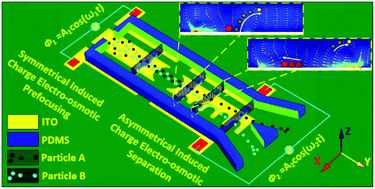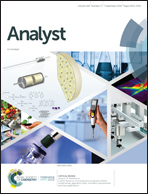Microparticle separation using asymmetrical induced-charge electro-osmotic vortices on an arc-edge-based floating electrode†
Abstract
Five arc-shaped gaps were designed on the bipolar electrode to actuate alternately opposite-direction asymmetrical induced-charge electro-osmosis (AICEO) vortices, and we developed a microfluidic device using such asymmetrical vortices to realize particle separation. When the buoyancy force dominates in the vertical direction, particles stay at the channel bottom, experiencing a left deflection under the vortices in the convex arc areas. In contrast, when the levitation force induced by AICEO vortices overcomes the buoyancy force, particles are elevated to a high level and captured by right vortices, undergoing a right deflection under the vortices in the concave arc areas. Moreover, when particles pass through the concave or convex arc areas every time, their right or left deflections are enlarged gradually and the separation becomes more complete. Remarkably, as the light/small particles at low voltage, heavy/large particles can be elevated to a new high level and undergo right deflection by increasing the voltage. We first explicitly proved the separation principle and analyzed numerically its capability in density- and size-based separation. Depending on the study of the voltage-dependent AICEO characterization of 4 μm silica and 4 μm PMMA particles, we experimentally verified the feasibility of our device in density-based separation. According to the investigation of sensitivity to particle size, we separated multi-sized yeast cells to confirm the capability of our device in size-based separation. Finally, we extracted yeast cells from impeding particles, obtaining 96% purity. Additionally, we designed a 500 μm distance between the focusing and separation region to circumvent the problems caused by electric-field interaction. Our AICEO-based separation method holds potential to serve as a useful tool in transesterification of microalgal lipids to biodiesel and solar cell processing because of its outstanding advantages, such as gentle conditions, contact-free separation, high-sensitivity and high-efficiency separation capability.



 Please wait while we load your content...
Please wait while we load your content...